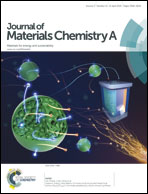An ion exchange mediated shape-preserving strategy for constructing 1-D arrays of porous CoS1.0365 nanorods for electrocatalytic reduction of triiodide†
Abstract
Based on a coordination chemistry approach, the present work reports on the synthesis of thin films of various cobalt hydroxycarbonate nanostructures such as nanobeams, nanoneedles, and bending nanorods using three different cobalt precursors viz. Cl−, NO3− and CH3COO−. After pyrolysis in air, the hydroxycarbonate nanostructures are transferred into 1-D arrays of Co3O4 nanorods. The obtained 1-D Co3O4 nanostructures are then transformed into the corresponding analogous shaped 1-D arrays of porous cobalt sulfide (CoS1.0365) nanostructures using a wet chemical transformation method based on an ion exchange approach. The nanostructured films before and after the ion exchange reaction are characterized using field emission electron scanning microscopy, X-ray diffraction, energy dispersive X-ray spectroscopy, X-ray photoelectron spectroscopy, transmission electron microscopy (TEM), and inductively coupled plasma mass spectroscopy (ICP-MS) measurements. As a proof-of-concept demonstration for the application, various shaped CoS1.0365 nanorod films synthesized are investigated as a Pt-free counter electrode in dye-sensitized-solar cells (DSSCs). The influence of three different counter anions of the cobalt precursors on the structural, textural, and morphological aspects, and thereby their influence on electronic and electrochemical properties, has been investigated. A correlation among electrical conductivity, charge transfer resistance and electrocatalytic performance of various CoS1.0365 nanorod films obtained from different cobalt precursors has been established. Among the various nanostructures, the thicker nanorod film synthesized using a chloride precursor has demonstrated the best electrocatalytic behavior toward triiodide reduction, which led to a short circuit current density of 18.04 mA cm−2 and energy conversion efficiency of 7.4% of the DSSC. This photovoltaic performance is highly competitive to a current density of 18.26 mA cm−2 and energy conversion efficiency of 7.7% exhibited by the standard Pt counter electrode.


 Please wait while we load your content...
Please wait while we load your content...